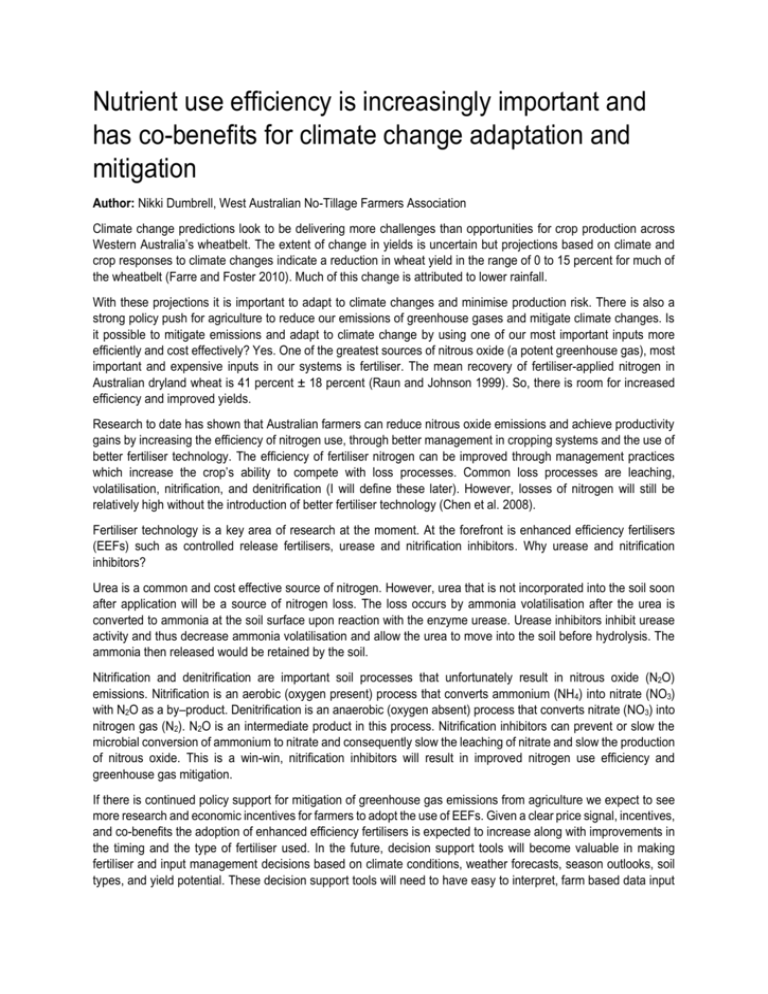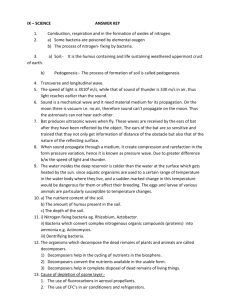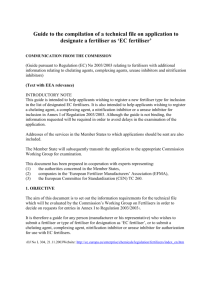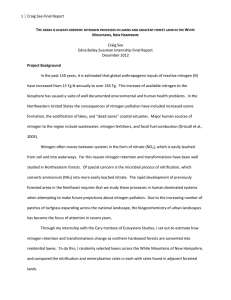Nutrient use efficiency has co-benefits for farm profit and
advertisement

Nutrient use efficiency is increasingly important and has co-benefits for climate change adaptation and mitigation Author: Nikki Dumbrell, West Australian No-Tillage Farmers Association Climate change predictions look to be delivering more challenges than opportunities for crop production across Western Australia’s wheatbelt. The extent of change in yields is uncertain but projections based on climate and crop responses to climate changes indicate a reduction in wheat yield in the range of 0 to 15 percent for much of the wheatbelt (Farre and Foster 2010). Much of this change is attributed to lower rainfall. With these projections it is important to adapt to climate changes and minimise production risk. There is also a strong policy push for agriculture to reduce our emissions of greenhouse gases and mitigate climate changes. Is it possible to mitigate emissions and adapt to climate change by using one of our most important inputs more efficiently and cost effectively? Yes. One of the greatest sources of nitrous oxide (a potent greenhouse gas), most important and expensive inputs in our systems is fertiliser. The mean recovery of fertiliser-applied nitrogen in Australian dryland wheat is 41 percent ± 18 percent (Raun and Johnson 1999). So, there is room for increased efficiency and improved yields. Research to date has shown that Australian farmers can reduce nitrous oxide emissions and achieve productivity gains by increasing the efficiency of nitrogen use, through better management in cropping systems and the use of better fertiliser technology. The efficiency of fertiliser nitrogen can be improved through management practices which increase the crop’s ability to compete with loss processes. Common loss processes are leaching, volatilisation, nitrification, and denitrification (I will define these later). However, losses of nitrogen will still be relatively high without the introduction of better fertiliser technology (Chen et al. 2008). Fertiliser technology is a key area of research at the moment. At the forefront is enhanced efficiency fertilisers (EEFs) such as controlled release fertilisers, urease and nitrification inhibitors. Why urease and nitrification inhibitors? Urea is a common and cost effective source of nitrogen. However, urea that is not incorporated into the soil soon after application will be a source of nitrogen loss. The loss occurs by ammonia volatilisation after the urea is converted to ammonia at the soil surface upon reaction with the enzyme urease. Urease inhibitors inhibit urease activity and thus decrease ammonia volatilisation and allow the urea to move into the soil before hydrolysis. The ammonia then released would be retained by the soil. Nitrification and denitrification are important soil processes that unfortunately result in nitrous oxide (N2O) emissions. Nitrification is an aerobic (oxygen present) process that converts ammonium (NH4) into nitrate (NO3) with N2O as a by–product. Denitrification is an anaerobic (oxygen absent) process that converts nitrate (NO3) into nitrogen gas (N2). N2O is an intermediate product in this process. Nitrification inhibitors can prevent or slow the microbial conversion of ammonium to nitrate and consequently slow the leaching of nitrate and slow the production of nitrous oxide. This is a win-win, nitrification inhibitors will result in improved nitrogen use efficiency and greenhouse gas mitigation. If there is continued policy support for mitigation of greenhouse gas emissions from agriculture we expect to see more research and economic incentives for farmers to adopt the use of EEFs. Given a clear price signal, incentives, and co-benefits the adoption of enhanced efficiency fertilisers is expected to increase along with improvements in the timing and the type of fertiliser used. In the future, decision support tools will become valuable in making fertiliser and input management decisions based on climate conditions, weather forecasts, season outlooks, soil types, and yield potential. These decision support tools will need to have easy to interpret, farm based data input backed by comprehensive and process-based agro-ecosystem models for optimum nitrogen fertiliser management (Chen et al. 2008). References Chen, D., Suter, H., Islam, A, Edis, R, Freney, J. and Walker, C. (2008) Prospects of improving efficiency of fertilizer nitrogen in Australian agriculture; a review of enhanced efficiency fertilizers, Australian Journal of Soil Research, 46: 289-301. Farre, I. and Foster, I. (2010) Impact of climate change on wheat yields in Western Australia. Will wheat production be more risky in the future? In: Dove, H. & Culvenor, R. A. (eds.) 15th Australian Agronomy Conference Lincoln, New Zealand. Raun WR, Johnson GV (1999) Improving nitrogen use efficiency for cereal production. Agronomy Journal, 91: 357–363. This is project “Overcoming barriers for West Australian growers to participate in the Carbon Farming Initiative” is supported by funding from the Australian Government.











